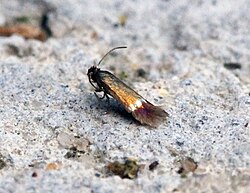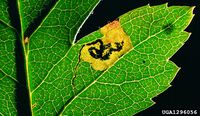Biology:Stigmella hybnerella
| Stigmella hybnerella | |
|---|---|

| |
| Scientific classification | |
| Domain: | Eukaryota |
| Kingdom: | Animalia |
| Phylum: | Arthropoda |
| Class: | Insecta |
| Order: | Lepidoptera |
| Family: | Nepticulidae |
| Genus: | Stigmella |
| Species: | S. hybnerella
|
| Binomial name | |
| Stigmella hybnerella = (Hübner, 1796)
| |
| Synonyms | |
|
List
| |
Stigmella hybnerella also known as the greenish thorn pigmy is a moth of the family Nepticulidae. It is found in all of Europe, in North Africa, the Near East, and the eastern part of the Palearctic realm.[1] The larvae mine the leaves of trees and shrubs such as hawthorns and rowans.
Description
Males of the species have a black head and golden-green coloured forewing with a white fascia distad to which the wing has purple hues . Females have black heads too, but sometimes orange.[2] The wingspan is 4–5 millimetres (0.16–0.20 in). Adults are on wing from April to May and again from July to August. There are two generations per year.[3]
Ecology
The larvae feed on snowy mespilus (Amelanchier ovalis), Cotoneasters, Midland hawthorn (Crataegus laevigata), common hawthorn (Crataegus monogyna), small-flowered black hawthorn (Crataegus pentagyna), common whitebeam (Sorbus aria) and wild service tree (Sorbus torminalis). They mine the leaves of their host plant. The mine consists of a slender corridor, with a relatively broad, continuous, frass line, that always leaves a clear margin at either side. This corridor winds freely through the leaf. This initial corridor widens into a blotch that mostly lies along the leaf margin. Pupation takes place outside of the mine.[4]
Etymology
Stigmella hybnerella was described by the German entomologist Jacob Hübner in 1796 from a type specimen found in Europe. The genus Stigmella – ″stigma″, refers to the conspicuous (or occasionally metallic) small dot or a brand fascia on the forewing of many of the Stigmella species, or possibly the small size of the moths. The species name hybnerella refers to Jacob Hübner, who seems to have named the moth after himself; although Maitland Emmet suggests it was probably proposed by another entomologist.[5]
References
- ↑ "Stigmella hybnerella (Hübner, 1796)". Fauna Europaea. August 29, 2013. http://www.faunaeur.org/full_results.php?id=431874. Retrieved 2 February 2023.
- ↑ "Stigmella hybnerella". Norfolk Moths. http://www.norfolkmoths.co.uk/micros.php?bf=990. Retrieved 2 February 2023.
- ↑ "Stigmella hybnerella". UK Moths. https://ukmoths.org.uk/species/stigmella-hybnerella/. Retrieved 2 February 2023.
- ↑ "Stigmella hybnerella (Hübner, 1796)". Plant Parasites of Europe. https://bladmineerders.nl/parasites/animalia/arthropoda/insecta/lepidoptera/monotrysia/nepticuloidea/nepticulidae/stigmella/stigmella-hybnerella/. Retrieved 2 February 2022.
- ↑ Emmet, A Maitland (1991). The Scientific Names of the British Lepidoptera. Their history and meaning. Colchester: Harley Books. pp. 45 & 47. ISBN 0-946589-35-6.
External links
Wikidata ☰ Q1759131 entry
 |


